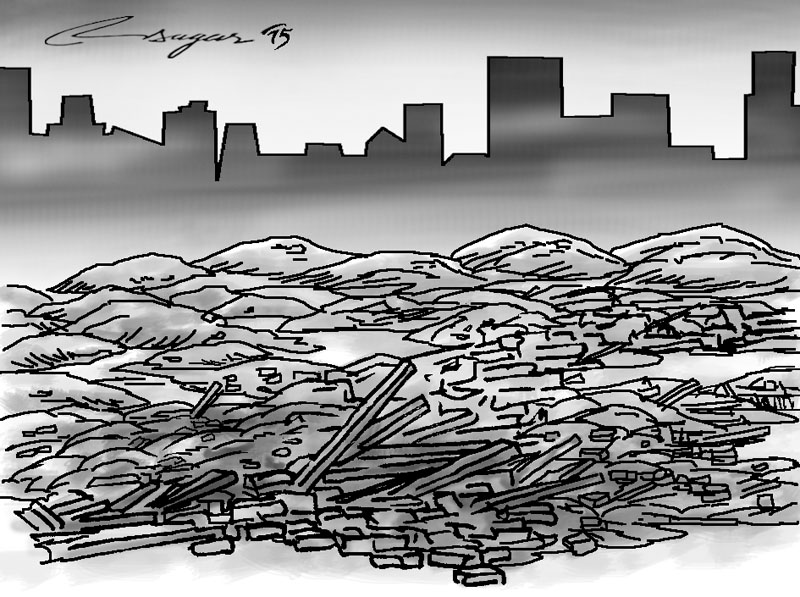Reconstruction materials
The damaged areas in central Nepal are nowadays more occupied by the rubble of solid wastes like bricks. These materials are discarded as solid wastes though embracing those materials for future reconstruction works is direly needed
The April 25 Gorkha earthquake and several big aftershocks have knocked down some 469,539 houses partially or completely. As monsoon is set to pack up soon, discussions are being voluble in favour and opposition of rapid reconstruction in Nepal. However, auspicious remarks from the proponents are still lax and somber resolutions are not made till date. The reconstruction authority has not fulfilled the quorum and opinions of the stakeholders are often befogged. Primary concern regarding reconstruction framework has not switched yet towards the resource constraints and re-usability of the past materials.
The money problems are almost resolved now and the spotlight should illuminate the resources for reconstruction. Enormous quantities of bricks, timber, mortar, among others, are immediately required for kicking off the reconstruction though adequacy of these materials is not assured. The damaged areas in central Nepal are nowadays more occupied by the rubble of solid wastes like bricks and rubble concrete. Apparently, these materials are discarded as solid wastes though embracing those materials for future reconstruction works is direly needed so as to minimize the cost and address the issues of resource constraints. The increasing encroachments on clay, timber and other resources like sand, gravels and stones (SG&S) have led to severe threats to the ecosystems, environmental losses and other types of threats to livelihoods.
Recently agencies are being anxious for the unmanageable quantity of rubble in Kathmandu Valley; however even if the quantity of solid waste may be equal to a decade’s contribution, plausible solutions are not far from us. Those technologies could be more benevolent in case of endorsement and brought into effect. Recycled concrete may be ideal solution for concrete debris; in addition to this, the leftover bricks shouldn’t be displayed stockpiling in the streets, rather their re-usability in terms of soling work or re-manufacture should be considered.
The virgin top soil and other good clay for brick manufacturing are not easily available nowadays in Kathmandu, thus reusing the brick pieces in the form of filling materials or recycling as new bricks are surely a viable solution for Nepal. The environmental degradation from brick kiln chimneys should be reconsidered for every urban setup; there are some clear indications of smoke effects in the north-eastern part of Kathmandu Valley where the majority of the brick kiln chimneys are situated.
The enormous quantity of construction materials shouldn’t be expected to be supplanted necessarily by fresh construction materials. In doing so, grave threat towards the environment and ecosystem would be inevitable. Thus, obscure challenges should be convertible into the prognosis of recycling and reuse. In case of industrialized recycling and reusing being functional, the desired quality of construction materials could be reassured by blending some additives along with the rubble.
In the era of “Building Back Better”, paradigm shift in terms of quality of construction materials and technology need meticulous judgment. Leaving the loopholes uncorrected and being indifferent in exploitation of natural resources will lead to crestfallen implementation of projects with uneconomic outlets. Didacticism from the 2015 Gorkha earthquake should be incorporated in Nepalese reconstruction milieu, otherwise we may not surpass future calamities of more intensity and brutality. Previous studies had been a harbinger of the somber devastation in the entire Nepal Himalayas, though we are more enticed in our feckless attempts of construction to selection and preparation of construction materials. The sagacity of aid agencies may be rendered for ameliorating the speculative interventions in construction industries, moreover there are several silver linings illuminated after the Gorkha earthquake, both in capacity building as well as material selection. Thus, selection of construction materials should be based on the demand of the specificity of structures. Rewarding the conventional bizarre selection criteria and chasing the aim of seismic safety and multi-hazard safety are somehow more like an utopia.
However, exacting efforts of recycling and re-usability at least in some marginal works may be pivotal in cost-effective reconstruction of Nepalese structures and heritages. Rubble is not waste, rather it has potential to be converted into good construction materials, which ultimately resolves the issues of solid waste management in the other hand wisely. Immediate establishment of recycling industries rather than revitalizing the aggravated brick kiln chimneys should be the priority of the Government of Nepal before people throw away all the debris beside the streets.
The Government of Nepal has suggested several building drawings; it nevertheless bolsters the quality of construction materials adequately. This hiatus is clearly reflected in those knocked down buildings of Sitapaila and Gongabu where a vertical re-bar is still standing and horizontal ties are dismissed and the sand and aggregates are isolated largely instead of keeping intact and properly bonded. Similarly, the bricks from Maju Dega (Kathmandu Durbar Square), Sankhu and Bungamati should be judged and strengthened for future reuse.
Gautam is a risk reduction engineer






